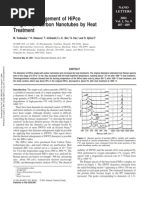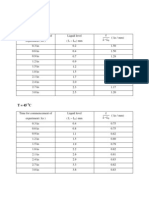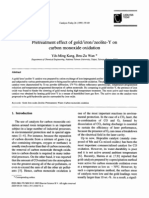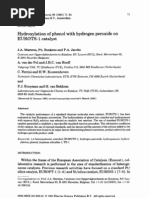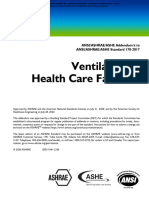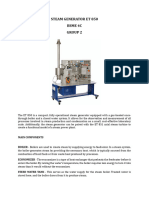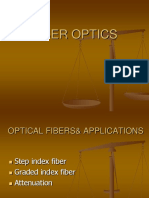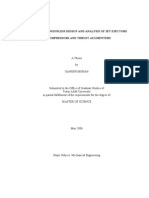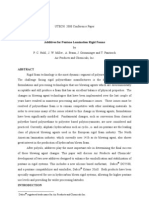Cat App 003 (E)
Cat App 003 (E)
Uploaded by
Alexander NhuanCopyright:
Available Formats
Cat App 003 (E)
Cat App 003 (E)
Uploaded by
Alexander NhuanOriginal Title
Copyright
Available Formats
Share this document
Did you find this document useful?
Is this content inappropriate?
Copyright:
Available Formats
Cat App 003 (E)
Cat App 003 (E)
Uploaded by
Alexander NhuanCopyright:
Available Formats
BEL-CAT Application note
CAT-APP-003
TPR measurement
2 July, 2003 Kazuyuki Nakai Kaori Nakamura TPR is the abbreviation of Temperature Programmed Reduction(Reaction), and it is used as a method to evaluate reduction of catalyst by hydrogen. There are a number of applications such as supported copper catalyst 1), heteropoly acid 2), nickel catalyst 3), oxide such as Bi-Mo or Fe-Sb 4), supported V2O5 5) or Re catalyst 6). It seems that TPR is influenced by experimental condition, especially active gas (H2) concentration, gas flow rate and catalyst volume more easily than TPD is. Therefore, these have to be carefully looked at.
[Introduction]
Experiment involves recording hydrogen concentration change or reaction product amount in carrier gas during temperature up as a function of time or temperature. TPD instrument can be used, but if TCD is used as the detector, it is necessary to mount H2O trap before the detector. The following equation is suggested for calculating energy of activation from TPR curve.
TP2 E ln + p ln[G ]m + (q 1) ln[S ]m = r + const. RTP
(1)
Here, [G]m and [S]m mean hydrogen gas concentration and element concentration of catalyst at peak temperature respectively, and p and q indicate reaction order for each concentration respectively. In general, p and q cannot be determined accurately, thus it is often set as p=q=1. 7) Iwamoto et al carried out TPR measurement of copper ion exchange Y-type zeolite (CuNaY) in the range of 273~1123K (Fig.1) 8).
Fig.1: TPR curve of CuNaY
BEL-CAT Application note
CAT-APP-003
4 reduction peaks appear at 473(I), 593(II), 803(III) and 1123(IV). Hydrogen consumption amount is approx. 0.5mol(H2)/mol(Cu) in each range, 273~773K and 773~1273K. Whole ESR spectrum of Cu2+ disappears by 775K reduction. The color of the sample changes from blue-green (273K) to white (nearly=773K) then to chestnut (>800K). Strong IR adsorption of Cu+-CO can be identified in 773K reduction sample, but Cu+-CO cannot be identified in 1173K sample. TPD peak 9) that attributes to Cu-O-Cu can be obtained by measuring TPD curve of CuNaY that is reduced at 473K. Considering the above results etc., Iwamoto et al attribute 4 reduction peaks to the following reduction process. 2Cu2++H22Cu++2H+ Cu2+-O2--Cu2++H22Cu++H2O 2Cu++H22Cu0+2H+ (peak I) (peak II) (peak III, IV)
This experimental method is extended to apply for mordenite or Cu2+ exchanger of ZSM-5 10), and it has become an important method for studying the characteristics of metal ion in zeolite framework. Also, there is a case that whole reduction amount is determined by chemisorption measurement by oxygen pulse at room temperature cooled down after TPR measurement. In this case, poor reproducibility of TPR and linearity problem can be covered by oxygen pulse method.
[Experiment and Result]
In TPR measurement, it is necessary to detect hydrogen concentration change. In BEL-CAT, TCD is used as the detector, and with He carrier gas that is often used for ammonia TPD it is difficult to detect it due to small specific thermal conductivity difference from H2. Therefore, in case of detection by TCD, H2 carrier gas diluted with Ar is often used. Also, it is necessary to trap the water that is produced by reduction reaction before TCD detector. In BEL-CAT, zeolite 4A is filled in the sample cell for pulse measurement (until the lower part of the cell is filled up), and high temperature pretreatment (400 degree C in carrier gas) is carried out in the reaction section, and then it is advised to remove moisture in the trap section.
G
R1
AV1
PA 1 TA 1
FL
PV6 PG6 FM1
(0.4ml) (1.2ml)
VENT
TC 1
TCD MFC Ref INJ
FL 6WAV1 6WAV2
4WMV1
TCD Sen VENT
PV1 PG1 3WAV4 FL EV1
G
6WAV3
FL
FL
2 Trap/N
MV1 R2 PV2 PG2 AV2
3WAV1 3WAV2 3WAV3
NV1
FL FL
VENT
TA 2
H2 O2 Aux.
3WMV1
FL
PV3 PG3
G
FL
PV4 PG4
G
T IC A 1
FL
PV5 PG5
FL
Fig.2: BEL-CAT flow diagram and example of TPR measurement setting
BEL-CAT Application note
CAT-APP-003
Instrument S/N Detector Sample Gas Heating rate
: BEL-CAT-2 : TCD (Half-diffusion type 4 element) : CuO (Wako Pure Chemicals Industries, Ltd. : 5% H2/Ar : 10 degree C/min.
Lot No.APJ4311)
Pretreatment program: Gas 1: H2/Ar Measurement program: Waiting time for TCD stabilization Target temperature Heating rate Target temperature holding time 20 min 1000 degree C 10 degree C/min 30 min in 60 Target temperature 30
1500000
1200000
0.14730 g 0.03370 g 0.01174 g
TCD [V]
900000
600000
300000
0 100 150 200 250 300 350 400 450 T [] 500 550 600 650 700
Fig.3: CuO TPR spectrum Fig.3 shows that shape of peak significantly changes only as sample mass changes. Also, shape of the peak of sample weight 0.14g indicates that hydrogen concentration is saturated as the introduced hydrogen is completely consumed. When such spectrum is obtained it is better to decrease sample amount or to increase hydrogen concentration in carrier gas.
BEL-CAT Application note
CAT-APP-003
Reference:
1) T. Takezawa, H. Kobayashi, Surface, 20, 555 (1982); S.J. Gentry, P.T. Walsh, J. Chem. Soc., Faraday Trans. 1, 78, 1515 (1982); m. Shimokawabe, N. Takezawa, H. Kobayashi, Bull. Chem. Soc. Jpn., 56, 1337 (1983); F.S. Delk II, A. Vavere, J. Catal., 85, 380 (1984). 2) H. Niiyama, H.Tsuneki, E. Echigoya, Nippon Kagaku Kaishi, 996 (1979); S. Yoshida, H. Niiyama, E. Echigoya, J. Phys. Chem., 86, 3150 (1982); K. Katamura, T. Nakamura, K. Sakata, M. Misono, Y. Yoneda, Chem. Lett., 89 (1981). 3) F. Nozaki, R. Adachi, J. Catal., 40, 166 (1975); J.M. Jenkins, B.D. McNicol, S.D. Robertson, Chem. Tech., 7, 316 (1977); R. Burch, A.R. Flambard, J. Catal., 85, 16 (1984). 4) H. Miura, Y. Morikawa, T. Shirasaki, J. Catal., 39, 22 (1975); W. Ueda, C. Chen, K. Asakawa, Y. Morooka, T. Ikawa, Chem. Lett., 135 (1984); M. Shimamura, F.Nozaki, Nippon Kagaku Kaishi, 1879 (1982) 5) M. Niwa, Y. Murakami, J. Catal., 76, 9 (1982); F. Roozeboom, M.C. Mittelmeijer-Hazeleger, J.A. Moulijn, J. Medema, V.H.J. de Beer, P.J. Gellings, J. Phys. Chem., 84, 2783 (1980); M.Iwamoto, J.Hirata, T.Takenaka, K.Matsuue, S.Shikagawa, Catalyst, 24, 276 (1982) 6) B.H. Issacs, E.E. Petersen, J. Catal., 77, 43 (1982); R.L. Mieville, ACS Meeting, p464, Steatle (1983); R.J. Bertolacini, R.J. Pellet, Studies in Surface Science and Catalyst, vol.6, p73, Elsevier (1980); M. Komiyama, Y. Ogino, Y. Akai, M. Goto, J. Chem. Soc., Faraday Trans. 2, 79, 1719 (1983) 7) S.J. Gentry, N.W. Hurst, A. Jones, J. Chem. Soc., Faraday Trans. 1, 75, 1688 (1979) 8) M. Iwamoto, H. Nagano, H. Furukawa, S. Kagawa, Chem. Lett., 471 (1983); M.Iwamoto, Y.Nagano, M.Nakamua, S.Oura, S.Shikagawa, Catalyst, 24, 303 (1982) 9) M. Iwamoto, M. Nakamura, H. Nagano, S. Kagawa, T. Seiyama, J. Phys. Chem., 86, 153 (1982) 10) M.Iwamoto, K.Ozaki, S.Shikagawa, Catalyst, 25, 368 (1983); M.Iwamoto, T.Taga, T.Konishi, S.Shikagawa, Catalyst, 26, 324 (1984) 11) M.Iwamoto, Characterization of solid catalyst, Catalyst course 3, 145, Koudansha (1985)
You might also like
- 11.3 KernDocument78 pages11.3 KernChou ChouNo ratings yet
- Zavoli Alisei NDocument37 pagesZavoli Alisei Ngabigg8459No ratings yet
- Tetrahydrofuran (THF) Storage and Handling: Basf IntermediatesDocument20 pagesTetrahydrofuran (THF) Storage and Handling: Basf IntermediatesRidho AmaliaNo ratings yet
- Activity Coefficients of The Tetramethyl Compounds of Group 14 Elements in N-Alkane Solutions From g.1.c. MeasurementsDocument7 pagesActivity Coefficients of The Tetramethyl Compounds of Group 14 Elements in N-Alkane Solutions From g.1.c. Measurementsm_adnane_dz3184No ratings yet
- Manage TEG Liquid and Corrosion in Sales Gas Pipelines PDFDocument7 pagesManage TEG Liquid and Corrosion in Sales Gas Pipelines PDFfhtgerthrgergNo ratings yet
- 3.0 Material Modeling Guidelines-V11-1 PDFDocument33 pages3.0 Material Modeling Guidelines-V11-1 PDFRahul MahajanNo ratings yet
- Land Rover Freelander 2006 - 2010 (Ingles)Document3,208 pagesLand Rover Freelander 2006 - 2010 (Ingles)Guillermo Granados100% (3)
- 4.0 Preliminary Design of Equipment HeuristicsDocument10 pages4.0 Preliminary Design of Equipment Heuristicssolehah misniNo ratings yet
- Temperature Programmed Desorption MeasurementDocument4 pagesTemperature Programmed Desorption MeasurementImran KhanNo ratings yet
- PP.1995 - Vapor Pressure of Tri-N-Butyl PhosphateDocument4 pagesPP.1995 - Vapor Pressure of Tri-N-Butyl PhosphatefalconeyerNo ratings yet
- Vapour in Air DiffusionDocument12 pagesVapour in Air Diffusionshivangsharma105629No ratings yet
- Efecto de La Calcinacion de Tio2-Al2O3Document6 pagesEfecto de La Calcinacion de Tio2-Al2O3El Aro De La CalleNo ratings yet
- Obtention of Tio Rutile at Room Temperature Through Direct Oxidation of TiclDocument4 pagesObtention of Tio Rutile at Room Temperature Through Direct Oxidation of TiclWilliam Soracà OspinoNo ratings yet
- Methane Steam ReformingDocument8 pagesMethane Steam ReformingPanda BoyNo ratings yet
- PP 106-110 Modeling & Simulation of Water Gas Shift Reaction JALPADocument5 pagesPP 106-110 Modeling & Simulation of Water Gas Shift Reaction JALPAEditorijset IjsetNo ratings yet
- Chowdhury 1993Document12 pagesChowdhury 1993korope8705No ratings yet
- Chapter 8aDocument157 pagesChapter 8aSolehah OmarNo ratings yet
- Am1c05586 Si 001Document16 pagesAm1c05586 Si 001Ismael Antonio González RamirezNo ratings yet
- Isotope Hydrology Laboratory, IAEA, Vienna Now at Lamont-Doherty Earth Observatory, Columbia University, New YorkDocument59 pagesIsotope Hydrology Laboratory, IAEA, Vienna Now at Lamont-Doherty Earth Observatory, Columbia University, New YorkEduardo IbarraNo ratings yet
- Flash Dehydration of Ulexite and Investigation of Dehydration Kinetics From Thermogravimetric DataDocument11 pagesFlash Dehydration of Ulexite and Investigation of Dehydration Kinetics From Thermogravimetric DataEmílio LobatoNo ratings yet
- RoleofReinPtReTiO2WGS Seshan 2008Document12 pagesRoleofReinPtReTiO2WGS Seshan 2008leonardoNo ratings yet
- 1Document7 pages1Ankit GargNo ratings yet
- Energija Aktivacijepaper Icdl 2011 - 6roDocument5 pagesEnergija Aktivacijepaper Icdl 2011 - 6rovzimak2355No ratings yet
- AC Catalst PTDocument5 pagesAC Catalst PTJarretNo ratings yet
- Catalytic Reforming of Methane With Carbon Dioxide Over Nickel Catalysts II. Reaction KineticsDocument26 pagesCatalytic Reforming of Methane With Carbon Dioxide Over Nickel Catalysts II. Reaction KineticsDiego LVNo ratings yet
- Traduci RDocument5 pagesTraduci RCamilo MartinezNo ratings yet
- Steam ReformingDocument24 pagesSteam ReformingRodrigo Farias100% (2)
- Experiment of Gas ChromatographyDocument11 pagesExperiment of Gas ChromatographyMohd Sukri DaudNo ratings yet
- November 2011 ChE Board Exam Questions PDFDocument8 pagesNovember 2011 ChE Board Exam Questions PDFMikee Felipe100% (1)
- Mechanical Engineering 2Document28 pagesMechanical Engineering 2Aashrith ParvathaneniNo ratings yet
- Rase - Chemical Reactor Design - Vol 2-Case 101Document9 pagesRase - Chemical Reactor Design - Vol 2-Case 101Md.Faysal Ahamed Khan0% (1)
- Preparation and Characterization of Peroxo Titanic Acid Solution Using TiclDocument6 pagesPreparation and Characterization of Peroxo Titanic Acid Solution Using TiclThanh ThủyNo ratings yet
- Physical DesulfurizationDocument29 pagesPhysical DesulfurizationHossam Mohamed KandilNo ratings yet
- ProblemSet8 SolutionscompleteDocument11 pagesProblemSet8 SolutionscompleteAnshu Kumar Gupta100% (1)
- Crystal Structures of Ceo - Zro - Ta O Ternary System Studied by Rietveld MethodDocument14 pagesCrystal Structures of Ceo - Zro - Ta O Ternary System Studied by Rietveld MethodtaifisicaNo ratings yet
- PrimaOuders, Feb 2011Document3 pagesPrimaOuders, Feb 2011emediageNo ratings yet
- Synthesis and Characterization of Pbtio Nanopowders by Citric Acid Gel MethodDocument4 pagesSynthesis and Characterization of Pbtio Nanopowders by Citric Acid Gel MethodChaitanya RaiNo ratings yet
- 7.flash DistilerDocument35 pages7.flash DistilerNa-na OktaviaNo ratings yet
- PabloM 13Document2 pagesPabloM 13Sofia CabarcasNo ratings yet
- Hydrolysis of TiCl4 - Initial Steps in The Production of TiO2Document10 pagesHydrolysis of TiCl4 - Initial Steps in The Production of TiO2Cuong Ky NguyenNo ratings yet
- Gas DiffusionDocument6 pagesGas DiffusionAkashoujo AkariNo ratings yet
- Atomic Layer Deposition of TiO2 From Tetrakis (Dimethylamino) Titanium and H2ODocument7 pagesAtomic Layer Deposition of TiO2 From Tetrakis (Dimethylamino) Titanium and H2OAilinJlsNo ratings yet
- Pretreatment Effect of Gold/iron/zeolite-Y On Carbon Monoxide OxidationDocument11 pagesPretreatment Effect of Gold/iron/zeolite-Y On Carbon Monoxide OxidationhernandeszNo ratings yet
- Ni Catalysts With Mo Promoter For Methane Steam ReformingDocument7 pagesNi Catalysts With Mo Promoter For Methane Steam ReformingGeorge CojocaruNo ratings yet
- 1 s2.0 S1385894721019550 mmc1Document20 pages1 s2.0 S1385894721019550 mmc1sripantNo ratings yet
- Hydroxylation of Phenol With Hydrogen Peroxide On EUROTS-1 CatalystDocument14 pagesHydroxylation of Phenol With Hydrogen Peroxide On EUROTS-1 Catalystapi-19973331No ratings yet
- Arc Plasma Processing of PT and PD Catalysts SupportedDocument4 pagesArc Plasma Processing of PT and PD Catalysts SupportedFei ZhouNo ratings yet
- 2.1.1 Temperature Programmed Reduction/Oxidation/Desorption (TPR/O/D)Document4 pages2.1.1 Temperature Programmed Reduction/Oxidation/Desorption (TPR/O/D)AnnafiNo ratings yet
- Diffusion Coefficients, Solubilities, and Permeabilities For He, N eDocument8 pagesDiffusion Coefficients, Solubilities, and Permeabilities For He, N eElenaNo ratings yet
- ThermalanalysismethodsDocument11 pagesThermalanalysismethodsnuriyym1No ratings yet
- Tetrahedron Letters Volume 40 Issue 5 1999 (Doi 10.1016/s0040-4039 (98) 02540-4) Francisco JoséRomero-Salguero Jean-Marie Lehn - Synthesis of Multitopic Bidentate Ligands Based On Alternating PyDocument4 pagesTetrahedron Letters Volume 40 Issue 5 1999 (Doi 10.1016/s0040-4039 (98) 02540-4) Francisco JoséRomero-Salguero Jean-Marie Lehn - Synthesis of Multitopic Bidentate Ligands Based On Alternating PyJoakin BahamondesNo ratings yet
- Preparation, Crystal Structure and Enhanced Bipolar Response of 0.90BLNT-0.10BCT Lead-Free PiezoceramicsDocument5 pagesPreparation, Crystal Structure and Enhanced Bipolar Response of 0.90BLNT-0.10BCT Lead-Free Piezoceramicshéma tologieNo ratings yet
- Romero JuarezDocument3 pagesRomero JuarezglsancorNo ratings yet
- Articles: Structural Investigation of The Hydrolysis-Condensation Process of Modified Titanium IsopropoxideDocument5 pagesArticles: Structural Investigation of The Hydrolysis-Condensation Process of Modified Titanium IsopropoxideDeddy Triyono Nugroho AdiNo ratings yet
- Peningkatan Whiteness by CeO2Document5 pagesPeningkatan Whiteness by CeO2Annas NursyahidNo ratings yet
- Kinetics Acetone Hydrogenation Over Pt/A1203 Catalysts: F. Rositani, GalvagnoDocument7 pagesKinetics Acetone Hydrogenation Over Pt/A1203 Catalysts: F. Rositani, GalvagnoNaufal AdityasNo ratings yet
- Chapter 7Document34 pagesChapter 7ShahrizatSmailKassimNo ratings yet
- 1983 - Eisenberg - Cyclic Response of Reversible Hydriding Alloys in Hydrogen Containing Carbon MonoxideDocument8 pages1983 - Eisenberg - Cyclic Response of Reversible Hydriding Alloys in Hydrogen Containing Carbon MonoxidejavalitetimosoNo ratings yet
- ManualDocument55 pagesManualRohit SubramanianNo ratings yet
- Gas Hydrates 1: Fundamentals, Characterization and ModelingFrom EverandGas Hydrates 1: Fundamentals, Characterization and ModelingDaniel BrosetaNo ratings yet
- Gas Hydrates 2: Geoscience Issues and Potential Industrial ApplicationsFrom EverandGas Hydrates 2: Geoscience Issues and Potential Industrial ApplicationsLivio RuffineNo ratings yet
- Experimental and Theoretical Approaches to Actinide ChemistryFrom EverandExperimental and Theoretical Approaches to Actinide ChemistryJohn K. GibsonNo ratings yet
- Ventilation of Health Care Facilities: ANSI/ASHRAE/ASHE Addendum K To ANSI/ASHRAE/ASHE Standard 170-2017Document9 pagesVentilation of Health Care Facilities: ANSI/ASHRAE/ASHE Addendum K To ANSI/ASHRAE/ASHE Standard 170-2017Tony Baylon SolimanNo ratings yet
- Steam GenDocument2 pagesSteam GenSabado, Rico Angelo L.No ratings yet
- Hydro Power PlantDocument18 pagesHydro Power PlantRahul Chaukiyal100% (1)
- Guc 1785 58 26972 2022-12-06T10 31 32Document118 pagesGuc 1785 58 26972 2022-12-06T10 31 32Maria HaddadNo ratings yet
- 2.4 - Membranes: 2.4.1 - Draw and Label A Diagram To Show The Structure of MembranesDocument6 pages2.4 - Membranes: 2.4.1 - Draw and Label A Diagram To Show The Structure of MembranesDuong TongNo ratings yet
- Question PDFDocument5 pagesQuestion PDFGurmeet KaurNo ratings yet
- Testing The Thermal Properties of Advanced Ceramics: Standard Guide ForDocument16 pagesTesting The Thermal Properties of Advanced Ceramics: Standard Guide ForSakarin Waiyakul100% (1)
- Case Study WakefieldDocument1 pageCase Study WakefieldAIRPOWER ENGENHARIANo ratings yet
- Piping - Fire FightingDocument3 pagesPiping - Fire FightingSathiyamoorthy TNo ratings yet
- Chemical Kinetics Lecture NotesDocument27 pagesChemical Kinetics Lecture NotesRicosushiNo ratings yet
- CNH18LDB) +submittal Multi-Zone Slim+Duct 01052022Document2 pagesCNH18LDB) +submittal Multi-Zone Slim+Duct 01052022pablo torreNo ratings yet
- NUCLEOSYNTHESISDocument20 pagesNUCLEOSYNTHESISchuryeon100% (1)
- Boilers HistoryDocument13 pagesBoilers HistoryVITAL100% (1)
- Pedometer ManualDocument4 pagesPedometer Manualkwano007No ratings yet
- Optical CommunicationDocument19 pagesOptical Communicationanon_118391344No ratings yet
- Hytek Overfill PrevantionDocument6 pagesHytek Overfill Prevantionj8164322No ratings yet
- Electric Submersible PumpingDocument2 pagesElectric Submersible PumpingWiryan JagadRNo ratings yet
- Exercise 2 - Week 2Document4 pagesExercise 2 - Week 2Thành MinhNo ratings yet
- U.S. Navy, LM2500 Gas Turbine Condition Monitoring Development ExperienceDocument9 pagesU.S. Navy, LM2500 Gas Turbine Condition Monitoring Development ExperienceJolito RamosNo ratings yet
- Gas EjectorDocument93 pagesGas EjectorDina SalehNo ratings yet
- 40DCOE18Document2 pages40DCOE18BRT_RacingNo ratings yet
- AP Chemistry Summer Assignment 2017Document44 pagesAP Chemistry Summer Assignment 2017John SmithNo ratings yet
- Toppling and StabilityDocument4 pagesToppling and Stabilityyashna bhandariNo ratings yet
- Practical Physics It 102 (1)Document106 pagesPractical Physics It 102 (1)Ahmed SayedNo ratings yet
- CounductometryDocument13 pagesCounductometryK.R. PrasadNo ratings yet
- UTECH 2000, Additives For Pentane Lamination Rigid FoamsDocument12 pagesUTECH 2000, Additives For Pentane Lamination Rigid Foamszhangp6No ratings yet



































